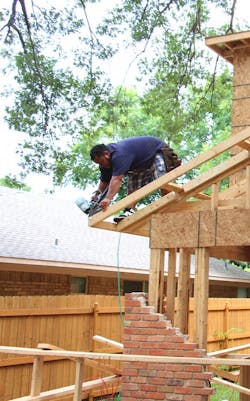If you check out James J. McCullagh Roofing, in suburban Philadelphia, on the Better Business Bureau website, you’ll notice that the company has an A+ rating. But call the number listed on the site and you’ll discover that it’s been disconnected.
The BBB does many things for businesses, but one thing it doesn’t do is enforce on-the-job safety. That’s the responsibility of the Occupational Safety and Health Administration, a federal agency known as OSHA.
OSHA became aware of James J. McCullagh Roofing on June 21, 2013. On that date a worker repairing the roof of Old Zion Lutheran Church, in Philadelphia, fell 45 feet after a roof bracket scaffold he was standing on collapsed. Fifty-two-year old Mark Smith died upon impact. The scaffold had been designed to hold one worker but there were two on it.
Six months later, in January 2014, OSHA cited James J. McCullagh Roofing with 10 alleged safety violations, including three willful violations, meaning “the employer either knowingly failed to comply with a legal requirement or acted with plain indifference to employee safety.” The agency levied $71,600 in fines on the roofer, and in the case of the fatal fall at the church, cited the company for failure to provide proper safety protection, including adequate scaffolding and safety harnesses.
Directed to Falsely State
Roofing companies are regularly cited by OSHA—in fact, it happens more frequently now than it ever has, due to increased agency vigilance. But the McCullagh Roofing case didn’t end with a fine. A year and a half after the fatal event, company owner James J. McCullagh was indicted in federal court on six separate counts, including obstruction of justice. McCullagh was accused of lying to OSHA investigators on four occasions about both the circumstances of the accident and about the company’s safety procedures.
The company owner claimed that employees had been tied off—wearing safety harnesses attached to anchor points on the roof—when he had visited the jobsite earlier in the day. But OSHA’s investigation found no forms of safety equipment on the site. Investigators also learned that McCullagh had instructed his employees to falsely state that they had fall protection. In December, McCullagh, 60, facing a maximum sentence of 25 years and a fine of $1.5 million, pleaded guilty in federal court to obstruction of justice, four counts of making false statements, and willfully violating an OSHA regulation that caused the death of an employee. He has been sentenced to 10 months in prison.
What to Do, What Not to Do
On-the-job fatalities are relatively rare. According to OSHA, 4,679 workers were killed on the job in 2014. That averages out to 3.3 workplace fatalities per 100,000 full-time equivalent (FTE) workers. It may not seem like a huge number, given that there are, right now, 121,410,000 FTE workers in the U.S. But it averages to about 90 people per week. Before OSHA was created in 1971, an average of 14,000 workers died on the job each year in the U.S.
Statistically, work-related fatalities are far more common in construction. Of the 4,679 fatalities on the job, 4,251 occurred in private industry, and 874 (or 20.5 percent) of those were in construction. And while the agency has no data on how many roofing companies actually follow its fall-protection standards, what OSHA does know is that falls are far and away the leading cause of construction fatalities. The agency traces the majority of construction fatalities to what it calls the “Fatal Four”: falls (39.9 percent), electrocutions (8.5 percent), individuals struck by an object (8.4 percent), and those crushed by equipment such as bulldozers or forklifts (1.4 percent). So, not surprisingly, falls have become OSHA’s major concern when it comes to enforcing workplace safety on construction sites.
After the Fall
Following an accident like the one that happened at Old Zion Lutheran Church, someone—usually whoever is in charge of the jobsite—will contact the police, the fire department, or an ambulance. Those first responders are likely to contact OSHA as well. It’s possible that an OSHA investigator could be at the jobsite before the company owner arrives there. But whether or not OSHA has been contacted by another person, the owner is still required to notify the agency within eight hours of a fatal accident. That reporting requirement is extended to 24 hours for an incident that results in hospitalization, amputation, or the loss of an eye. These reporting rules were set in place by OSHA at the beginning of last year.
What’s the Plan?
McCullagh’s actions in lying to investigators and ordering his employees to do the same may have been a desperate attempt to extricate himself from a legal mess. If the stakes are high enough, people will lie, and lie big, if they think they can get away with it. Owners who find themselves confronted with this kind of situation often do things that aren’t in their best interests, notes Florida attorney Trent Cotney who specializes in OSHA cases.
Typically, a fatal jobsite injury isn’t something for which contractors prepare. They have no protocol in place. There’s no plan of action that says who will do what and when. That leaves the company owner to fumble through a situation that’s thoroughly unfamiliar and he or she is therefore apt to make mistakes that can be costly at best, or, as with James McCullagh, a complete disaster.
“The issue that a lot of contractors face,” Cotney says, “especially smaller ones, is that they get emotionally invested and they don’t put their business hat on. They need to get a game plan. They need to think about it before it’s too late.”
Managing the Aftereffects
That plan, in the event of a fatal fall or life-threatening accident on site, should take into account the following.
Prepare for an investigation. Expect an OSHA investigation to begin shortly after you contact the agency. OSHA inspectors will be on site within hours and will want to interview everyone who was on the jobsite. They will likely map the site to see who was where at the time the accident occurred. They will work to determine the sequence of events leading up to the accident. OSHA will also be looking to see whether or not the hazard that caused the accident has been removed. Investigators will want to see safety equipment and will want proof that you operate safely as standard procedure, including proof of training workers in safe practices.
Have an attorney present. OSHA will likely want to investigate other jobsites you’re working on, plus your shop and warehouse, and will conduct interviews with all the employees there. The investigator has a right to interview anyone, and he or she can speak to them without the owner present. But Cotney advises that you, as the owner, are best served by having those interviews take place in your offices, rather than at that jobsite. Company owners, he says, will likely be interviewed by a variety of state and federal agencies, and any statements can be used as evidence. For that reason, he suggests that the company owner have an attorney present when being interviewed by any authority, including OSHA investigators.
Respond as the leader. It’s your company, your crew, and ultimately it’s your responsibility. That’s how employees see it. You will have employees who are upset and possibly confused. They will look to you to take charge. Responding decisively and with empathy will have a calming effect. If you respond awkwardly or inappropriately, you run the risk of creating additional turmoil and long-term damage to morale, not to mention inviting a civil suit.
New OSHA Rules for Accident Reporting
When an accident happens on a jobsite, the last thing a contractor may be thinking about is reporting the incident to the appropriate government agency. But that’s the law. Before last year, employers were required to report to OSHA three or more work-related fatalities or inpatient hospitalizations and any work-related hospitalizations of three or more employees. Beginning last year, those requirements changed. Under the new rules, employers must report not only work-related fatalities, but all work-related hospitalizations, amputations, and any work-related loss of an eye within 24 hours.
OSHA updated its reporting rules in an effort to reduce overall injuries.
“… too often, after a fatality, when we inspect, we learn that other workers have already been injured at that establishment,” says David Michaels, assistant labor secretary for occupational safety and health. —JC
Encouraging a culture of safety means equipping and educating crews so that they avoid unsafe jobsite practices.
Stop work and find out what happened. What you should do, Cotney says, is immediately stop work and ensure that no one else is in harm’s way. “A lot of companies will shut down the job for the day and do an investigation while the evidence is still intact,” he adds.
Show compassion and concern. “Regardless of personal injury or liability, you must console employees and the family of the deceased,” Cotney says. “Show you are human and let them know that your concern is not business-related.” Issue a statement of condolences indicating that you share the grief of fellow employees and the survivors of the deceased. Be there for any memorial or religious service.
Avoid publicity but be ready for it. Work to keep the accident out of the media. In no way do you benefit from the adverse publicity that the association of your company with this tragedy will attract. It is possible, though, that media, through police or fire contacts, will be aware of what happened and will be on the scene looking for someone to comment. If that’s the case, that source should be you and no one else. Make it clear to staff, when you announce the death, that questions about what happened should come only to you.
“That’s where most contractors get in trouble,” says Scott Siegal, Certified Contractors Network president and owner of Maggio Roofing, in Takoma Park Md., which had a fatal fall occur in 2007. “[Employees] go out and talk to people. They think they’re doing damage control. We’ve always instructed our people that there is only one person who should talk to an investigator, and that is the person in charge.”
Have a short message prepared. Express regret at what happened and condolences to the friends and family of the deceased. Treat this as a private matter—you don’t owe the world, or the media, a lengthy explanation.
Notify your insurance company. An attorney can advise you in the event that survivors of the deceased file a lawsuit. But you should also call your insurance company because, in most cases, Cotney points out, a workers’ compensation payout rules out potential lawsuits by survivors. Typically, beneficiaries file a workers’ comp claim for death benefits, which includes payment to survivors and an allotment for burial expenses. But a news story, even an obituary, could prompt a call from a personal injury lawyer. Winning a judgment would hinge on the ability of plaintiffs to prove gross negligence on your company’s part in matters of jobsite safety—a claim that statements (including your own) given during an OSHA investigation could very well be used to support.
Have a Plan in Place
With no plan in place, you’re left to try to manage whatever problem springs up as a result of a deadly accident. Even with an established plan, it won’t be easy. In the case of Maggio Roofing, a foreman unsnapped his roof harness from the anchor point to be able to inspect something at the edge of a flat roof and he fell two stories. Emergency personnel worked for an hour to save him, but the foreman died on the jobsite. Siegal says that, although the company did have a robust safety program and an emergency management protocol in place, the effect for him was so devastating that he considered selling his successful business. Instead, he eventually updated all safety measures and training. “It took me a while to realize that there are a lot of people who depend on this company for their livelihood,” Siegal says, “and it wouldn’t help anyone for me to close up shop.”
One of the first things an OSHA inspector willwant to know after an accident—something that will likely make a difference in whether or not that accident is followed by a lawsuit—is whether ornot your company:
1] Has a safety program in place with someone atthe company actually in charge of that program;
2] Requires all personnel to use safety equipmenton jobsites;
3] Trains workers in use of that equipment and in safety procedures; and
4] Proactively seeks to identify and control hazardson its jobsites.
OSHA’s current guidelines are outlined in the agency’s “Safety and Health Program Management Guidelines.”
Whether or not your company has a safety program in place is one of the first things an OSHA investigation will seek to determine. For instance, within an hour after a fatal fall on Maryland company Maggio Roofing’s jobsite in 2007, an OSHA representative appeared, sought out the project manager, identified himself, and “spent the afternoon checking the site for fall protection and any violations,” says company president Scott Siegal.
That jobsite inspection is typically only the beginning. In the case of Maggio Roofing, OSHA representatives showed up at the company’s offices the next day, intent on inspecting the premises. “They spent a day or two and interviewed every single employee,” Siegal recalls, “about the accident, safety, and equipment. They wanted to know: Do you have a safety program and do you teach it?”
Whatever program you have in place needs to be documented. “[We] will request that the employer provide all documents related to implementation, training, and enforcing the company’s safety program,” says OSHA’s deputy director, Dean McKenzie. If such documents don’t exist, it’s difficult to prove that your company has an actual safety program in place. It’s not enough to just buy equipment. What OSHA expects is not only that employees are trained in how to use that equipment, but that employees, as well as management, know how to identify and manage jobsite hazards. —JC
About the Author

Jim Cory
Philadelphia-based writer Jim Cory is a senior contributing editor to Professional Remodeler who specializes in covering the remodeling and home improvement industry. Reach him at [email protected].

